|
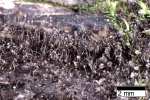
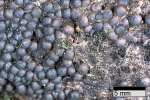
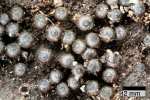
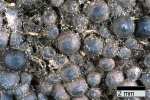
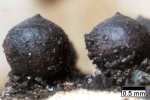
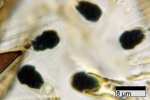
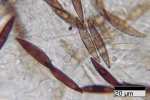
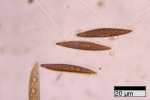
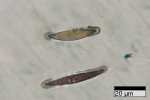
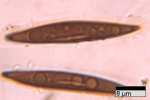
|
Rosellinia necatrix Prillieux.
Stromata densely gregarious, uniperitheciate, purplish brown
to black, subglobose with a constricted base and a flattened to conical discoid
apex, 1.3-1.5 mm high x 1.1-1.6 mm diam; ectostroma hard, carbonaceous; subiculum brown to purplish brown, abundant,
woolly, persistent at the base of mature stromata, long adhering to side walls,
usually conspicuous
between the stromata, mixed with synnematous structures bearing the anamorph.
Ostioles papillate, conical.
Asci cylindrical, with apical apparatus basally conical, apically
enlarged with a lateral rim, strongly amyloid,
6-9.5 µm high x 4.5-6 µm broad. Perithecial contents olivaceous in fesh material.
Ascospores 32-43 x 5.5-6(-8) µm, narrowly fusiform to navicular with
acute to pinched ends, inequilateral in side view, brown to dark brown, with a straight
to slightly oblique germ slit 8-13 µm long on the flattened side; slimy
sheath present at both ends extending on the flattened side.
Anamorph in nature: Dematophora necatrix, visible as grey tufts
on erect synnemata mixed with the subiculum.
Specimens examined:
FRANCE: Pyrénées Atlantiques (64),
Sauveterre de Béarn, 11 Nov. 1990, JFM-9335 ,
on Sambucus; Auterrive, Ile du Gave d'Oloron, 06 Nov. 2003, JF-03220,
on bark of a dead stump of Fraxinus excelsior; Auterrive, Ile
du Gave d'Oloron, 06 Nov. 2003, JF-03222, on a dead stump and roots of Sambucus
nigra.
Notes: Rosellinia necatrix is a well known taxon in literature
dealing with plant pathology, but best known for its anamorph than for its teleomorph
which is rarely reported. The period between anamorph stage and teleomorph may
extend over several years (Francis, 1985). Its rarity and the fact it has frequently
been confused with related taxa even led to doubt of its reality (Francis, 1985).
Rosellinia necatrix is quite easily identified in the field due to
its presence on roots or stumps and its relatively large stromata associated
with a conspicuous woolly subiculum at times bearing the grey tufts of conidiophores.
Rosellinia buxi is superficially similar, also grows on stumps and roots and
has a similar anamorph, but it is restricted to Buxus and differs from
R. necatrix by shorter ascospores lacking a slimy sheath. Interestingly,
these closely related species are both considered as dangerous pathogens (Francis,
1985, Petrini, 1993; Whalley, 1996)).
Rosellinia necatrix is known from Europe and North America (Petrini,
1993). Its reports from tropics (Rogers et al., 1987; San Martin &
Rogers, 1995; Ju & Rogers, 1999) are less frequent. According
to Francis (1985) and Petrini (1993; 2003), several tropical taxa close to R.
necatrix, including R. arcuata Petch and R. bothrina (Berk.
& Br.) Sacc.only differ in ascospore size and are likely to form a complex
of closely related species.
The root-pathogen action of R. necatrix explains its presence on roots
and base of stumps of various woody shrubs or trees, including fruit-trees (Malus,
Pyrus,Vitis). Whalley (1996) gives a full account of its pathogen activity
reported in literature. In France, R. necatrix seems to be not uncommon in Pyrénées Atlantiques, especially
on dead Sambucus nigra.
|